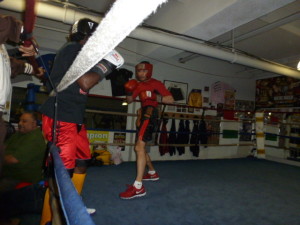
Note: Boxersandwritersmagazine has been less active in the last year. Fortunately, circumstances have changed to allow for more frequent publishing. Below is a book review written last year. Please enjoy and expect more Boxing writing that pulls no punches soon.
Yesterday I finished reading Rope Burns: stories from the corner, a collection of short stories by F.X. Toole. Published in 2000, these stories vividly display the true experience of the boxing world from within; manifesting nostalgic joy, laughter, and sorrows for those of us from that world who know it as intimately as our own hearts. The full spectrum of human emotion is generated from Toole’s scenes the same way physical and neurological reactions are generated from devastating, accurately delivered punches to the body and head by a world class professional boxer. Toole’s precision of delivery comes from a lifetime of research, having become a professional cut man after working with bull fighters in Mexico. His knowledge is similar to that of a perfectly balanced boxer who can punch from any angle to hit without getting hit, the narration and dialogue merging into rhythmic combinations that set us up, soften us up, preparing our hearts for the literary knockout blow.
The title story is the last in order and the longest in length, chronicling the relationship of Joseph Mary “Mac” McGee, a first generation Irish American retired Los Angeles police officer in 1992 training a poor black heavyweight, Henry ‘Puddin’’ Pye, who just qualified to represent the United States at the Summer Olympic Games in Barcelona, Spain. Training at the end of April and in early May when the LA riots over the police beating of Rodney King occurred, Toole skillfully shares the points of view of blacks, whites, police, civilians, Latinos and other ethnic groups in a fair depiction of neighborhood experience. The intermingling of triumph and tragedy, love and hate, humor and anger hooks the reader from the opening sentence to the final phrase lasting for nearly 80 pages. The third story, Million $$ Baby, is the only one chronicling the career of a female fighter, a reality that is strictly contemporary to our time. While there are a few details slightly and importantly different from its film adaptation, one thing that could be concluded from the film but is more strongly evident in the story is the narrative condemnation of assisted suicide, the evil of which Western society is now threatened with as contemporary culture forgets the moral compass which guided its growth for 2,000 years. The Irish immigrant culture and Catholic faith, fueled by a devotion to St. Jude, blankets the story with the sacred compassion of the human heart. The fifth story, Frozen Water, was combined into the film Million $$ Baby, and its examination of black and white race relations and the challenge for the strong to protect the week thematically captures the sentiments of honest boxers in all states of life, from the beginning days of amateur boxing to the old age experience of helping boys develop their manhood as a boxing trainer. These themes run through the story and are, like the water in a bottle kept cold in the freezer at night and melting in the heat of a gym the following afternoon, delivered deeply by the narrating trainer, Willie ‘scrap Iron’ DuPree, an old black trainer protecting a young vulnerable white man from the Ozarks. The remaining three stories, The Monkey Look, Black Jew, and Fighting in Philly, reveal the cutman’s care for the fighter and the fighter’s appreciation as well as the tendency to sometimes take advantage of one’s handlers as much as handlers and others in the boxing world sometimes take advantage of them. The Monkey Look deals with a cutman assisting a chronically bleeding fighter from Mexico needing help to get through his last chance at a world title with a plot twist calling into question his end of the financial deal in the corner; Black Jew tells of two cornermen helping a skilled veteran battle through the minefield of obstacles a promoter puts up in front of him in a world title elimination fight he can obviously win, and Fighting In Philly deals with hard blows that come from outside forces influencing the results that come from the action in the ring. The poignant observation in the narration comes from the central character, Con Flutey, as he mentally prepares to do his job before the fight:
Money was the name of the game, any game, and that made for corruption somewhere along the way. Most thought the game was corrupt because of the money. Con saw it otherwise, that there was money because of corruption.
Rope Burns; stories from the corner is a great read not only for those who want to learn more about Boxing and how it works, but for those interested in literary work that captures the drama of the human heart.




